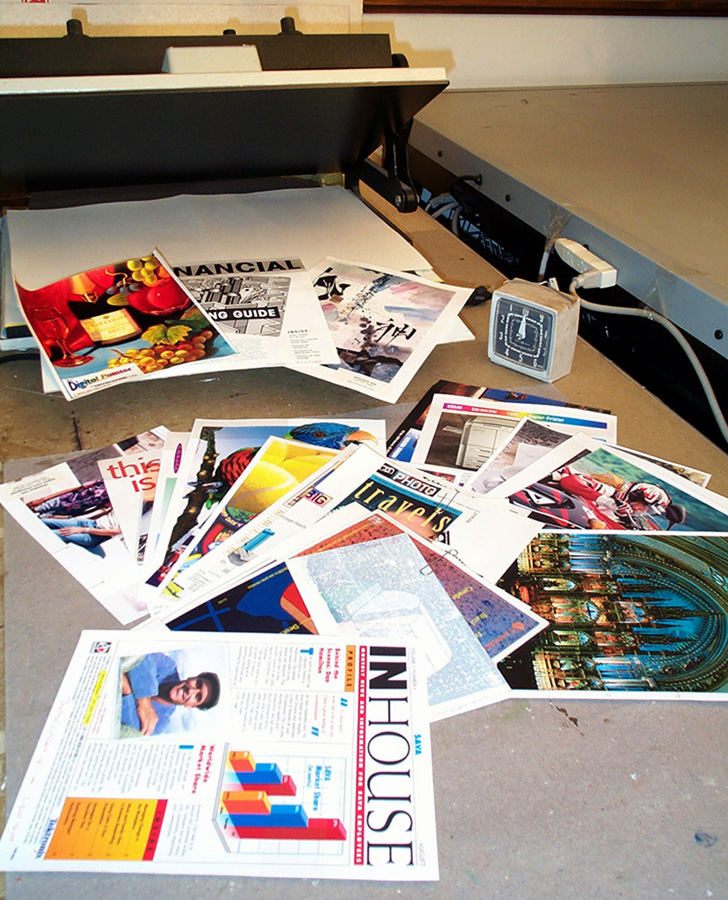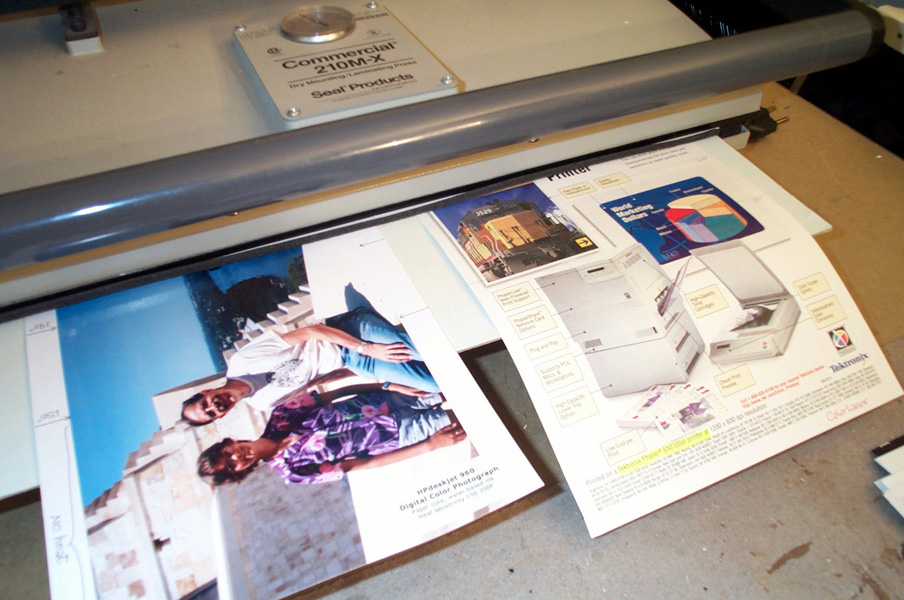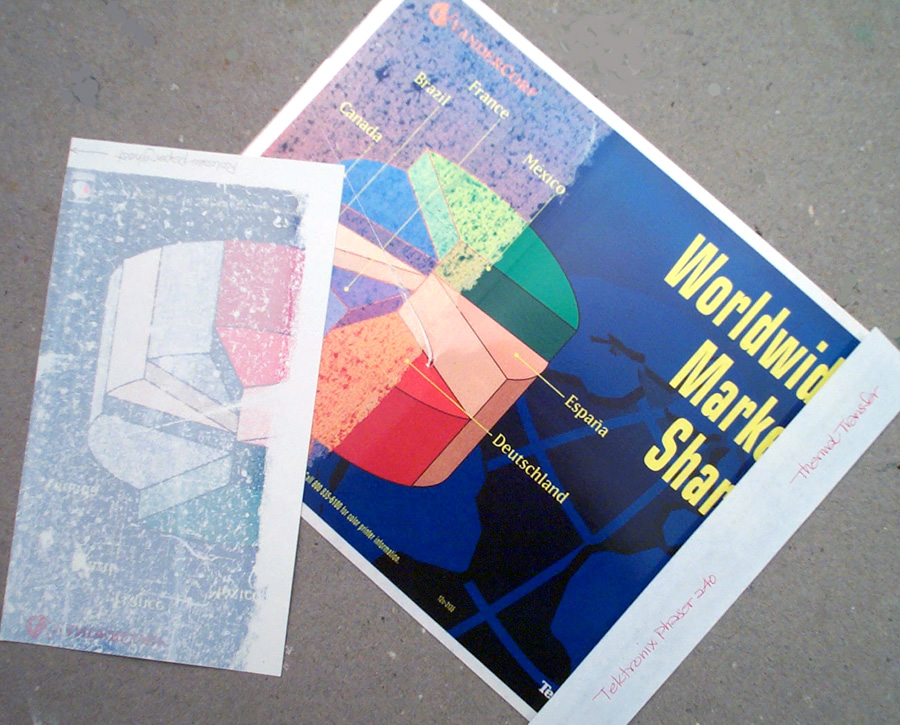 Photo 1
Photo 1
All digitals were mounted in a Seal 210M-X mechanical press 1 minute at temperatures ranging from 150°F to 220°F. Samples represented include all common digital technologies that might be suitable for framing.
Welcome to Digital Dilemmas with its ongoing search for understanding new art, photographs and graphic images. I have been researching mounting and handling of images for the picture framer since my affiliations with Seal Products back in the 80s. During the 90s, Seal researched new products and developed specialized presses to accommodate wide format prints for the commercial digital market, as we picture framers remained comfortable in our world of lithographs, RC photos and open edition reproductions. Then came giclees, digitals were born into custom framing and the rest is history.
Initial Electrophotographic Heat Testing
With the launch of four color copiers, picture framers first began noticing heat sensitivities with thermographic processes. Faxes turned black, colors often changed, and surface gloss was damaged at times when items were placed in heat presses. In 1996 after years of pestering Seal Products, Xerox and Kodak about how to best mount and handle these color copies (electrophotography), Seal finally commissioned me to do the testing necessary to establish heat tolerances for mounting and laminating of these printed images, and to come up with a basic set of user guidelines. The results of this year long test may be found in "Color Copies Parts I and II: From Lightfastness to Laminates" March and April, 1997, PFM and in The Mounting And Laminating Handbook, pg. 60, 102, 138-139.
Little did I realize that years later the dawn of digitals would send me off on yet another quest. But before reporting the results of the digital heat tolerance testing from 2001, the concepts of thermography should be explained a little to help lay the groundwork and fill in any blanks.
Thermographic Printing
In printing, thermography, meaning heated printing, is a raised-letter printing process that simulates engraved printing by applying a fusible powder to an oily, slow-drying wet ink prior to drying. The sheet is then passed under a heater to fuse the ink and powder. Some inks contain an expansion agent when exposed to heat create a raised letter effect.
When first tested back in the 80s, inexpensive business cards, stationery and wedding invitations with raised plastic thermographic lettering used to melt, flattening out into illegible blobs of ink if exposed to prolonged heat and pressure. Therefore cold mounting methods of wet, spray or pressure-sensitive applications were suggested. In recent spot testing this past year I have found many of these do currently hold up under heat. I suppose that means new technology has improved their tolerances.
Thermographic Photocopying
In thermographic photocopying or writing with heat, an original document and sheet of special copy paper are passed together through a machine that exposes them to heat, or infrared rays. The ink used on the original must contain a metallic or carbon compound in order to absorb the infrared radiation. The copy paper contains heat sensitive substance fused between a transparent sheet of paper and a white, waxy backing. The original heats the darkened areas of print and transfers the image to the copy sheet. These must be cold mounted.
Thermal or Nonimpact Printers
Impact printers and dot matrix printers use an inked ribbon to pressure apply an image onto a sheet of plain paper. Nonimpact printers require thermal or electrostatic transfers of the original image rather than mechanical means. See Mastering Mounting January PFM for more in-depth explanations of nonimpact printers found under the digital umbrella. Some are heat sensitive some are not as seen later in this article.
Facsimiles (Faxes)
Derived from the Latin facsimile "made like", it refers to a process of reproducing graphic material from a distance. A light sensitive device scans the image to produce an electric signal that is sent over telephone lines. Reproduction of the received copy can be on photographic, electric-sensitive, or thermal (heat-sensitive) paper.
Any fax produced from heat will continue to darken when further exposed to any heat source. Warmth from the sun, a mounting press, or even heat inside a frame may activate the paper thus darkening whites and blackening grays. Cold mounting is required for these images. Plain paper faxes do not have the same technology producing the image and are safe to dry mount with heat.
Mounting Questions
The on-going questions surrounding dry mounting of digitals and thermographic heat sensitive items has been answered for years by suggesting cold mounting alternatives. With the above thermographics the application of moisture in wet and spray adhesives has not routinely impacted them, but with today's digitals the water solubility of many inks prohibit some of the wetter mounting methods. I have often stated if you do not know the origin of an image do not dry mount it. Sounds as though you cannot wet or spray mount it either, making pressure-sensitive the only mounting alternative. It should come as no surprise that pressure-sensitive applications are the mounting of choice for most commercial digital and large format users.
Heat Tolerance Testing
In my attempt to resolve the mounting dilemma of digitals it was needed to do in-depth study about their tolerances. With the onset of digital photographs, that look remarkably like color RC photos, it seems necessary to find a mounting method besides preservation techniques, and p-s that might be safe for these hybrid images.
Dry mounting is the desired method for digitals. It is fast, permanent and involves no moisture, but in some instances, mounting temperatures can damage or melt the inks depending upon their printer technology. So in July 2001, I took it upon myself to seriously look into the heat tolerances of digitals. Last month in Mastering Mounting I wrote about the family tree of digital images and identified their technical workings. To date I have concluded two parts of this fact finding test: printer technologies and digital photos. I also expect these results may require constant refurbishing to keep up with the evolution of digital technology. What is true today will not be true tomorrow.
The Players
The first part of the test identifies common printers and their technology (photo 1). Although I had done the 1996 testing on copiers, new copier technology needed to be retested in this format. Printer samples in the test are as follows. Dry toner electrophotographic printers included Minolta CF900 and Canon 360PS. Electrostatic toner copiers included Xerox 2135 and 2006, Scitex Spontane, Kodak ColorEdge, and IBM 3170, while laser printers included Xerox N Series, DocuColor Phaser 2006, and Tektronix 550, 750 and 790. Thermal transfer printers included Kodak Digital Printer, Tektronix 240 (on film) and 440.
 Photo 1
Photo 1
All digitals were mounted in a Seal 210M-X mechanical press 1 minute at temperatures ranging from 150°F to 220°F. Samples represented include all common digital technologies that might be suitable for framing.
Inkjet thermal printers included bubble jet technology of HP DeskJet 960c on both paper and photo paper, Tektronix 140, and Digital Painter (on canvas). Inkjet phase change technology using a solid wax stick or puck that melts to be sprayed, included Tektronix 340 and 860.
Hypothesis
It has been known for a long time that dry mounting is the most long term permanent mounting method (aside from preservation applications) available to framers. It is also the most time and cost effective method. A truly low temperature mounting adhesive might be the answer. The test was completed to establish low end heat tolerances for the above technologies. This would better determine whether or not very low end heat mounting adhesives currently available in the custom framing market could compete with p-s mounting for digitals.
Since the release of the low temperature heat activated (HA) product called SpeedMount, from Nielsen Bainbridge, there has been the possibility of mounting digital images within a heat press. Since digital images are often fused under heated rollers at temperatures much higher than the 150°F/66°C mounting temperature offered by this particular product, it could be an answer to safely dry mounting previously heat sensitive items, but this theory needed testing.
Controls
All digitals were subjected to temperatures of 150°F (66°C), 170°F (77°C), 185°F (85°C), and 200°F (93°C). Heat tests were conducted in a Seal 210M-X Mechanical press, and the images were placed under the clamped platen using single sided release paper for a period of 1 minute at each temperature (photo 2). All tests were exactly the same. The test was preformed twice to help verify the results.
 Photo 2
Photo 2
Images were divided into sections that were subjected to timed heat exposures, so comparisons could be made within the context of all temperatures on one tested image.
The fast time/low temperature was selected specifically because of SpeedMount,which mounts at 150°F in 15 seconds. Other temperatures were chosen to match current industry dry mounting tissues. Because of the lack of substrate, 1 minute was adequate time for the mounting package to reach total bonding temperature. Currently 170°F bonds low end removable tissues and 185°F is considered the industry average for permanent tissues. The 200°F is the upper end adhesive film temperature not likely to be used with digital mounting, but gave an upper end mounting contrast.
Results at 150°F
Test results were surprising in some cases. All digitals with the exception of the inkjet on photographic paper passed the heat mounting test at the lowest temperature of 150°F. There were two images printed with an HP DeskJet 960c inkjet printer. One on absorbent porous paper which withstood the temperature as all the others had, one printed on nonabsorbent nonporous photo paper, which was damaged at the low temperature. The damage resembled the scuffing damage that silicone does to high gloss RC photos, totally unacceptable for framing.
What surprised me was that phase change images that are melted waxy ink sticks converted into a spray actually tolerated these low temperatures. Phase change inks will melt when subjected to heat, so even with the positive results of this test it is suggested to keep these images away from the heat.
Results at 170°F
The selected test temperatures and times were chosen to match current available low temperature tissue products as already mentioned. At twenty degrees hotter the resulting damage was inconsistent and a visible problem. Electrophotographic prints were both good and bad. Electrostatic images were more damaged at this temperature than not, and laser image results were also both acceptable and not acceptable.
I have been told that thermal transfers are heat sensitive, yet the Kodak photo quality, dye sublimation print did not melt at 150°F or 170°F as expected. However, the thermal transfer Tektronix 440 dye sublimation printer did transfer a ghost image at 170°F, while the thermal transfer on film melted altogether (photo 3).
 Photo 3: Melted Image
Photo 3: Melted Image
The left hand piece is a segment of the single-sided release paper used in the heat test of this Tektronix 240 thermal transfer image onto film. —Notice the inks have melted and transferred to the release paper (left) under the 170°F temperature also severely damaging the original (right).
RESULTS AT 185°F-220°F
By studying the included chart it is safe to say that if an image is visually damaged at 170°F it will not improve at higher temperatures. The few laser, inkjet, and one thermal transfer Kodak dye sublimation image that withstood the 170°F now needed to be checked at the higher average temperatures of 185°F-220°F. At these higher temperatures a few of the laser images did not pass the test, but the inkjet bubble jet technology still passed. The dry toner electrophotography images now began to show the removal of the glossed surface and the results were visually 50/50. Some images began to ghost onto the release paper. Be careful, this will transfer to the surface of the next unsuspecting project.
The Chart
The results are recorded on the chart as to positive tolerance or not. If an item is listed as yes it passes the visual requirements for a quality end product that would meet customer needs without damaging or threatening the digital image. If listed as no it was impacted by the heat and pressure combination and the viable alternative would be a pressure-sensitive board, or non-invasive preservation hinging.
Some results were marginal so when a 50/50 is listed it is a visual judgement call of the professional as to whether the mounting should be allowed. These 50/50 images show a slight hint of visual change but still rather subtle. These were also better on lighter colored images and more visibly damaged on darker surfaces. At no time was lightfastness, monetary or sentimental value, nor preservation noted, meaning a signed numbered limited edition giclée though it may tolerate heat of a mounting process should still never be subjected to dry, wet, spray, or pressure-sensitive mounting.
Recommendations
I feel that at 150°F (66°C) a standard custom picture framer will be able to heat mount many digital items previously damaged by the higher required heats. The chart illustrates the dramatic results all but one of the digitals being safe at 150°F and only slightly damaged at the higher 170°F. It remains to be seen as whether different papers will react to temperatures differently based on the absorption. A desktop inkjet printer such as the HP DeskJet 960c will safely mount and laminate at all temperatures from 150-220°F, but the same inks on a Kodak Professional Picture Paper for digital photographs is damaged at even 150°F.
It appears that there will always be a risk when attempting to mount any digital with heat, even the low 150°F, but the risks may be low enough and the digitals readily available enough to replace for the framer to take the mounting risk. SpeedMount could be the answer to current digital heat mounting needs, but it still remains a judgement call and the risks remain. Perhaps attempting to dry mount should only be attempted with additional image copies in reserve.
Laminates
The final test applied a narrow strip of nonperforated vinyl heat seal laminating film across the top edge which was then covered with sponge overlay and placed into a 220°F(104°C) press for a full 5 minutes to laminate. The reason behind testing a high temperature laminate with these digitals is that although an image may be heat sensitive and not approved for dry mounting at lower 170-185°F temperatures, the laminated result may be visually acceptable.
The damage that occurs at mounting temperatures is often the removal of the even gloss that occurs during the setting of inks or toner between heated fuser rollers during its printing. This partial removal of gloss may be camouflaged during the coating of a laminate over the image. But damage can also occur to inks when laminating. When it has been indicated a digital image does not tolerate laminating it may not be the temperature but rather the mounting adhesive of the laminate that impacts the resulting lamination. The binders used in the mounting process of some pigment inks are sensitive to the adhesive used to bond the laminate. When heated to laminating temperature they appear to release, float around, and reclump prior to setting. The resulting image appears clumped making fine type fuzzy or difficult to read, and solid color areas very pointillist like a Seurat painting. Though a few of the inkjet and dye sublimation images looked good in this test, the results showed that lamination is still not advisable on digital images.
Epilogue Notes
I am currently working on the American National Standards Institute (ANSI) committee for the standardization of heat and pressure-sensitive products for manufacturers as well as a document of suggested techniques for application. When complete we hope to submit these documents to the International Standards Organization (ISO) for their acceptance and approval. My heat tolerance testing as discussed in this column, and the next one to be reported in June, as well as my affiliation with the ANSI committee has generously been sponsored during 2001 by Nielsen & Bainbridge.
In my next installment of Digital Dilemmas I will address the second part of my testing. With the results of the current test the biggest question is over the varied results of the inkjet on plain paper vs. photo paper. Would all brands of nonabsorbent photo paper on the same HP DeskJet 960c react the same when mounted? It appears that digital photos are in a whole different world than either RC photos or digital images on plain paper. The results are interesting.
Watch for my in-depth results and another chart in June.
END
Copyright © 2002 Chris A Paschke
For more articles on mounting basics look under the mounting section in Articles by Subject.
Additional information on all types of mounting is found in:
The Mounting and Laminating Handbook, Second Edition, 2002,
The Mounting And Laminating Handbook, Third Edition, 2008 and
Creative Mounting, Wrapping, And Laminating, 2000 will teach you everything you need to know about getting the most from your dry mount equipment and materials as an innovative frame designer.
All books are available from Designs Ink Publishing through this website.
Chris A Paschke, CPF GCF
Designs Ink
Designs Ink Publishing
785 Tucker Road, Suite G-183
Tehachapi, CA 93561
P 661-821-2188
chris@designsinkart.com